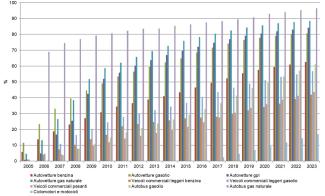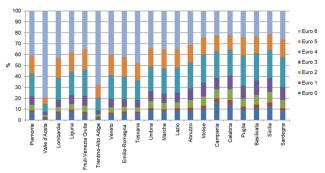Panel 1
Antonella Bernetti, Gianluca Iarocci
This indicator tracks the share of road vehicles complying with the most recent emission standards during the 2005-2022 period. In 2022, passenger cars still showed a non-negligible proportion (13.7%) of Euro 0 gasoline vehicles, while for diesel cars this share was significantly lower at approximately 2.9%. More concerning is the commercial vehicle fleet situation - predominantly diesel-powered - where 11.2% of light commercial vehicles (vans) and 27.1% of heavy goods vehicles remain at Euro 0 standard.
The indicator measures the share of the vehicle fleet that complies with the most recent and stringent emission standards for new vehicles. Harmful emissions in this sector are largely linked to the combustion of fossil energy sources; the use of appropriate technologies significantly reduces these emissions.
To monitor the share of the vehicle fleet that complies with the most recent emission standards for new vehicles.
Regolamento CE 715/2007
Regolamento CE 595/2009
Regolamento UE 459/2012
Regolamento UE 143/2013
Regolamento UE 136/2014
Regolamento UE 45/2015
Regolamento UE 1347/2017
Regolamento UE 858/2018
Regolamento UE 1832/2018
Panel 2
ACI (Automobile Club d'Italia), Studies and Research, various years, https://www.aci.it/laci/studi-e-ricerche.html
ISPRA (Istituto Superiore per la Protezione e la Ricerca Ambientale), National Inventory of Atmospheric Emissions, various years, https://emissioni.sina.isprambiente.it/inventario-nazionale/
ISPRA, Italian Emission Inventory 1990–2022, Informative Inventory Report 2024, Italian National Institute for Environmental Protection and Research, Reports 400/2024, https://emissioni.sina.isprambiente.it/wp-content/uploads/2024/05/IIR2024-Rapporto-400-2024.pdf
ISPRA, Italian Greenhouse Gas Inventory 1990–2022, National Inventory Report 2024, Reports 398/2024, https://emissioni.sina.isprambiente.it/wp-content/uploads/2024/05/NIR2024-Rapporto-398-2024.pdf
MIT (Ministero delle Infrastrutture e dei Trasporti), National Transport Infrastructure Report, Ministry of Infrastructure and Transport, various years, https://www.mit.gov.it/
-
-
Data quality assessment
ACI (Automobile Club d'Italia) MIT (Ministero delle Infrastruttura e dei Trasporti)
ACI (https://www.aci.it/laci/studi-e-ricerche/dati-e-statistiche/open-data.html)
MIT (https://www.mit.gov.it/)
National, Regional
2005–2022 (and regional data for the year 2023)
Indicator assessment
The percentages of the circulating vehicle fleet that comply with specific emission standards are derived from data provided by the Ministry of Infrastructure and Transport. These data, used for the preparation of the national air pollution emissions inventory, refer to the size of the national vehicle fleet in the year under study, broken down by vehicle type, fuel type, engine capacity or weight class, and Euro emission standard.
In Italy, the renewal of the vehicle fleet in accordance with environmental standards for new vehicles is progressing at a typical replacement rate. In 2022, regarding passenger cars, a non-negligible share of petrol vehicles still belonged to the Euro 0 class (13.7%), while the share for diesel cars was significantly lower, at approximately 2.9%. For mopeds and motorcycles, around 44.0% fall under Euro 0 and Euro 1 classes—the latter being equivalent to or worse than Euro 0 in terms of nitrogen oxide (NOₓ) emissions.
The situation is more concerning for the commercial vehicle fleet, which is largely diesel-powered. Among light commercial vehicles (vans), 30.8% of petrol and 16.7% of diesel vehicles are still classified as Euro I or lower. For heavy-duty goods vehicles, 32.0% remain in these older emission classes (Table 1). It is only from Euro IV onwards that significant reductions in nitrogen oxides and particulate matter emissions are observed in commercial vehicles.
Additionally, for heavy-duty commercial vehicles, real-world testing of Euro V models did not confirm the expected reductions in NOₓ and particulate emissions. More substantial improvements were instead achieved with the introduction of Euro VI vehicles.
Between 2005 and 2022, an increase was observed in the percentage of the circulating vehicle fleet compliant with Euro 4 or higher emission standards. However, the trend does not fully align with environmental targets, due to the continued presence of a significant share of vehicles compliant with older Euro standards and the predominance of fossil fuel-based propulsion systems.
In 2022, the share of the fleet compliant with Euro 4 or higher emission standards was as follows:
-
Petrol passenger cars: 60.9%
-
Diesel passenger cars: 79.9%
-
LPG passenger cars: 83.0%
-
Natural gas passenger cars: 87.9%
-
Light commercial petrol vehicles: 39.3%
-
Light commercial diesel vehicles: 54.8%
-
Heavy-duty vehicles: 40.7%
-
Diesel buses: 57.2%
-
Natural gas buses: 95.7%
-
Mopeds and motorcycles: 14.3%
Hybrid vehicle categories, which still represent a minor share of the circulating fleet, are compliant with the most recent Euro emission standards (Table 1 and Figure 1).
Data
Table 1: Distribution of circulating vehicles by category and Euro standard (2022)
ISPRA processing based on Motorization data (Ministry of Infrastructure and Transport)
The table reports percentage values referring to the circulating fleet.
Figure 1: Percentages of the circulating fleet compliant with Euro 4 standards or higher
ISPRA elaboration based on data from the Motorization Department (Ministry of Infrastructure and Transport)
Hybrid categories, always compliant with Euro 4 standards or higher, are not shown here for the purpose of comparison across years



The identification of a vehicle's Euro class refers to regulatory periods that vary significantly depending on the vehicle type. The type of vehicle also determines a high variability in both emissions per kilometre travelled and the reduction percentage of regulated pollutants (carbon monoxide, nitrogen oxides, volatile organic compounds, and particulate matter), which generally increases with more recent Euro classes. However, emissions across different vehicle types are not directly comparable—on average, heavy-duty vehicles emit more per kilometre than passenger cars or light commercial vehicles. Nevertheless, classification by Euro standard provides a concise overview that helps assess the penetration of less polluting vehicles within the circulating fleet.
Figure 1 shows the share of the national vehicle fleet that complies with stricter environmental standards. The renewal and technological upgrading of the vehicle fleet is closely linked to the average income level of the population. The penetration of newer vehicles is not uniform across the country.
In 2023, passenger cars in the regions of Apulia, Molise, Basilicata, Sicily, Calabria, and Campania still include a proportion of Euro 0 vehicles equal to or exceeding 10%. Moreover, in Sicily, Calabria, and Campania, over 25% of the fleet consists of "old-generation" vehicles (up to and including Euro 2). Conversely, in regions such as Tuscany, Lombardy, Trentino-Alto Adige, and Aosta Valley, vehicle fleets are more modern, with over 80% of the vehicles complying with the most recent emission standards (Euro 4 to Euro 6) (Figure 2).
Also in 2023, analysis of the industrial vehicle fleet—which includes light and heavy commercial vehicles as well as road tractors—indicates a more modern composition (Euro IV–VI) in the regions of Piedmont, Emilia-Romagna, Veneto, Tuscany, Lombardy, Trentino-Alto Adige, and Aosta Valley (Figure 3).